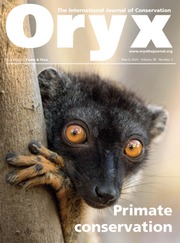The pied tamarin Saguinus bicolor is a small primate endemic to the Brazilian Amazon, occurring in the municipalities of Manaus, Rio Preto da Eva and Itacoatiara, with one of the smallest distribution ranges for a Neotropical primate (c. 8,000 km2). In Manaus, agriculture, industry, urban and infrastructure expansion, and human population growth have resulted in habitat loss and fragmentation through deforestation, and deaths and injuries of primates from vehicle collisions, electric shocks and attacks by domestic dogs. An additional threat is the expansion of neighbouring populations of the congeneric golden-handed tamarin Saguinus midas into the pied tamarin's range.
As a result, S. bicolor is categorized as Critically Endangered on the IUCN Red List and is one of the 25 most threatened primates globally. Since 2011, the National Action Plan for the Conservation of the Pied Tamarin (gov.br/icmbio/pt-br/assuntos/biodiversidade/pan/pan-sauim-de-coleira) has promoted the conservation of the species and its habitat, implementing actions to reverse its decline. This Plan is official public policy, designed, implemented and monitored through a participatory process coordinated by the Chico Mendes Institute for Biodiversity Conservation. Following the Plan's guidelines, the minimum area required to sustain a viable population is c. 10,000 ha, and three of the best preserved areas of this minimum size within the species’ distribution have been identified (Jerusalinsky et al., 2017, gov.br/icmbio/pt-br/assuntos/biodiversidade/pan/pan-sauim-de-coleira/1-ciclo/pan-sauim-de-coleira-livro.pdf).
One of these areas was evaluated in 2017 and 2018 for potential as a Biological Reserve. In 2023, procedures were resumed, with surveys, discussions with local communities and political negotiations. On 5 June 2024, Decree 12.047 was signed by President Luiz Inácio Lula da Silva, creating the 15,300 ha Pied Tamarin Wildlife Refuge, the first federal protected area for the species. The objectives of the Refuge are to protect forest areas relevant for the conservation of the pied tamarin, enhance habitat connectivity and promote the adoption of conservation-compatible agricultural practices. Designation as a Wildlife Refuge (rather than Biological Reserve) considers the needs of local communities by ensuring protection is compatible with agricultural production (e.g. of pineapple, a locally important crop) and permits activities such as primate watching.
The effectiveness of the Refuge will depend on an effective manager and staff, and allocation of the required equipment and resources. Ongoing dialogue with local communities and landowners will be crucial for agreeing best practices to reconcile environmentally sustainable agricultural production with protection of the species’ habitat. The creation of the Refuge also aims to advance research, education, law enforcement and communication, and to attract investment, improve the quality of life for local people and support other actions that promote the conservation of the iconic pied tamarin and associated biodiversity.

The pied tamarin Saguinus bicolor. Photo: Diogo Lagroteria.


